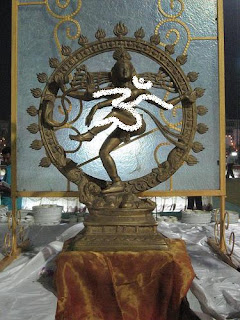There is eloquence in his being; there is purity in the air around him and the soft verses of praise rhythmically bathe the ambience for the seeker to listen.
Through the illusion of Atman, he who sees the universe exist within himself during his hours of sleep, like a city exists within a mirror, such that the universe looks like a manifestation of its own, he who beholds himself when awake, his own, the incarnate of the teacher, to him, the teacher who faces south, to him I bow.
He manifests himself in the bodies of all, of Brahma, of the devas, of Purusha (man) and of pashu(lesser animals). He is within those that are womb born, egg born, sweat born and earth born. When he is realized the world melts into him as if it were a blissful dream. And therefore I come into existence, I am life, I am consciousness, and I am pure.
Tat Tvam Asi
But I am a prisoner in this thick fog of Maya, my consciousness manifests itself as imagination, doubt, confusion, memory, determination, guess... Thus I adopt a school of thought, to understand and find, to realize myself. And thus I hold on to life, to meaning and to philosophy, to escape the clutches of this Maya that imprisons my mind. And so philosophy was born.
Charvaka: or Lokayatas hold that nothing is real except that which is revealed to the senses.
Kanada: founder of the Vaiseshika school of thought, believe that character and attributes are inherent in the atoms themselves and thus gives rise to objects of creation as well as their qualities.
Sugata: the popular Buddha believes Atman is not independent of the state of consciousness which is ever changing with every moment
Sankhyas: who follow the doctrines of Kapila and Patanjali, that the universe consists of two realities, Purusha(consciousness) and Prakriti(phenomenal realm of matter), the experience and the experienced, and where ultimate realization is achieved by following Ashtanga yoga.
Vedantins: who believe in the system of Sariraka-mimamsa, that explains the nature of Brahman
Pauranikas: who believe in the puranas that explain the creation of the universe and its beings and explain the histories and descriptions of various Gods and Goddesses.
Pratyakshas: who believe in sensuous perception, right knowledge obtained by sense organs coming in contact with external objects, like color is obtained through the eye.
Anumana: right knowledge obtained from the process of inference, that where there is smoke, there has to be fire. Hence the inference is fire as the presence of smoke reveals it.
Sabda: right knowledge obtained through verbal statement from a trust worthy source.
Upamana: right knowledge that is obtained from the process of comparison
Arthapatti: knowledge in the form of presumption, surmising a thing to account for something else that is known.
Abhava: immediate consciousness of the non existence of something by the non perception of it, therefore if it existed it should be perceived.
Sambhava: the right knowledge as to the existence of a part, when we know the whole of which it is a part also exists.
Aitihya: right knowledge obtained by centuries of tradition, transmitted generation to generation of which the source is unknown.
Srinivasan sighed, feeling the silence and bliss within him. Time doesn’t exist, its part of the very Maya we are engulfed with, Kala defines the change that is felt or perceived in that which is living, that which has prana, that which is Atman. Srinivasan stood bewildered with the thought of the great Lord of the South, who touches the consciousness, who governs the ever open mind into a state of everlasting bliss.
He had awoken to the truth of Dakshinamurthy and yet he could scarcely comprehend it. The truth echoed in his mind and yet the fog didn’t lift. The peace of equilibrium and high emotional bliss touched him and yet he felt it was momentary. The thought of coming back to this world brought his mind crashing into the depths of Maya we all know so well.
Srinivasan opened his eyes, Lord Dakshinamurthy continued to be in dhyana with his eyes closed. The apasmara purusha, the emblem of ignorance felt like that of Shrinivasan’s as he felt the warm force of divine Lord gently crush his “imagined” self. He was the seventh present, who tried hard to listen to the truth of the universe and yet those words felt like they fell on deaf ears.
Gurur Brahma Gurur Vishnu | Gurur Devo Mahesh Varaha||
Guru Shakshat Para Brahma|Tasmai Shri Guruve Namaha||
Guruve sarva lokaanaam Bhishaje bhava roginaam|
Nithyai sarvadhiyaanam Dakshinamurthaye namo namaha||
Guruve sarva lokaanaam Bhishaje bhava roginaam|
Nithyai sarvadhiyaanam Dakshinamurthaye namo namaha||
Content Courtesy:
Dakshinamurthy stotra of Sri Shankaracharya, text translated by Alladi Mahadeva Shastri


